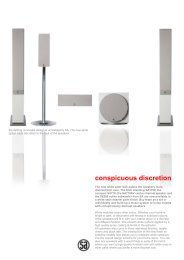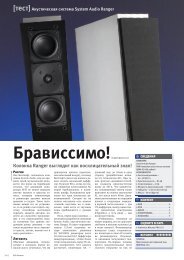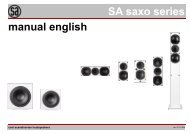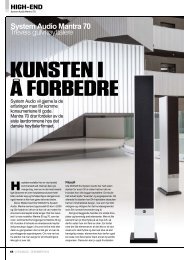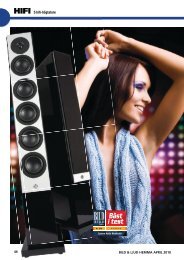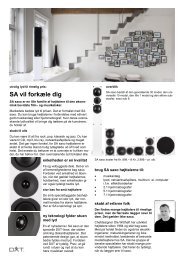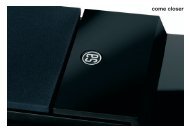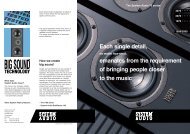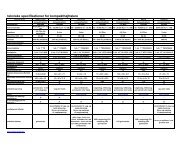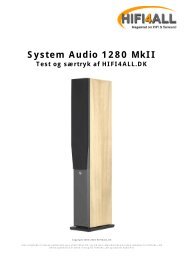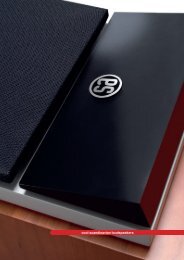PDF (2.3 MB) - System Audio
PDF (2.3 MB) - System Audio
PDF (2.3 MB) - System Audio
- No tags were found...
You also want an ePaper? Increase the reach of your titles
YUMPU automatically turns print PDFs into web optimized ePapers that Google loves.
WHAT FLAVOUR IS YOUR AUDIO?1J~~~(8~
---------------REVIEWI SPEAKERSROCKONSYSTEM AUDIO EXPLORER LOUDSPEAKERS DO A-------------LOT OF THINGS WELL, BUT THEY'RE KILLER ROCKERSBY ERNIE FISHERFOUNDED IN 1984 by Ole Wit~,manufacturer <strong>System</strong> <strong>Audio</strong>-began makingDanishwaves with a loudspeaker design that earnedaccolades from the Danish press as a "speakerthat sets new standards."The company namewas chosen to describe the manufacturer'sbelief that loudspeakers, when inserted into asystem configuration, will take on a uniquepersonality. The design under review is a bitdifferent from other speakers in the marketplace'(see Technology sidebar).AppearanceTHESE ENCLOSURES AREN'T much differentfrom any other six-sided loudspeakers, exceptthat the fit and finish is typically European,resulting in a tall and slim cabinet with immaculateveneer resting on larger plinths.The SoundTO ESTABLISHA loudspeaker's merit, I usuallyconnect it to as many amps as I have in-house.I connected the Explorers to my in-houseWyetech Lab Topaz amp (reviewed in Vo1.13,No.2)/Opal preamp (reviewed in Vol. 10, No.2)system, the Simaudio Moon Evolution system(reviewed in the last issue) and the MusicalFidelity kW integrated amp (reviewed in Vol.17,No. 1).The sole source component usedwas the Simaudio Andromeda CD player(reviewed in the last issue).JPS Labs Aluminata(reviewed in the last issue) and NordostValhalla (reviewed in Vol. 13, No. 2) cables, theNordost Thor power distribution centre(reviewed in Vol. 16, No.4) and the ExactPower EP-15A line conditioner (reviewed inVol. 16, No. 3) completed the set-up for all myauditioning sessions.First up, I used the Simaudio amp/preampcombo to drive the Explorers, playing backsome raunchy blues. I took the volume level38www.theinnerearmag.com
SPEAKERSslowly up to about 11OdB and was surprisedhow the speakers handled both low and highvolume with the same ability - steadfast andresolute across the entire frequency range.While not achieving absolute realism, thesound was quite spectacular. Classical musicfeaturing large orchestras didn't fare quite aswell as the numerous instruments merged alittle too much, packing the sound stage withthe performers without enough air. However,smaller ensembles, such as quartets - stringsin classical music and piano, drums, bas s andhorn in a jazz arrangement - finished withoutflaws and with the appropriate time and spaceelements to make the music quite realistic. IWhen it came to sophisticated and cerebralmusical material, such as Bach's organ arrangements,Vivaldi's The Four Seasons or Handel'sMessiah, l thought the Explorers did a veryrespectable job in all but the very top frequencies.These l found a little too much in my face,albeit without jarring or unpleasant shrillness.Next, I tried the Musical Fidelity amplifierand achieved similar results. While resolutionwas a bit diminished, musicality scored veryhigh. This was an easy-to-listen-to combination,providing the kind of listening thrill that makesone savour the music. Not surprising, theefficient Explorers sounded great when Iinserted the Wytech Labs Topaz/Opal combinationinto the system. The signature smoothnessof the Topaz and its ability to bios som with theright speaker combination were clearlyevident. I liked the sound of this configurationbest for it provided all the good stuff that Iappreciate in high-end audio: immaculateimaging, resolution through all frequencies,loads of space/air around instruments andgreat transparency.The Explorers' bass appeared to be quitegood, with resolution down to about 35Hz,although not very well defined below thatfrequency. My initial beef was that the basssounded detached from frequencies ab ove it,and I was about to grumble when I rememberedthe small opening on the front baffle,through which the enclosures can be filledwith lead-shot or sand. Well, I filled them withkitty litter, and - bang! - there it was, a muchmore coherent all-round sound. The bass nowhad weight and, in addition to extending resolutionto about 30Hz, blended well withfrequencies above. In fact, the audiblefrequency range became somewhat bettertempered, especially noticeable in the topfrequencies.lenjoy listening to music at approximatelythe same volume leveis I'd experience at a liveconcerto However, it wasn't until I hit rockconcertleveis that the Explorers soundedmost realistic with all amps employed for thisreview. When I increased the gain until volumehit 120dB and played back heavy rock, thespeakers captured the essential dynamics ofthe drums, the texture of the electric bass, thesound of an electric keyboard as well as thepitch of voices - all without a trace of distortion.There was no distortion. All in all, theExplorers' best performance was achievedwhen the loading cavity was filled with kittylitter, but I have a hunch (based on my pastexperiments with loading)that a combinationof lead shot and sand would have providedeven better sound.Synopsis & CommentaryEVERY LOUDSPEAKER MANUFACTURER hasa story, and some have opinions they'd likeyou to accept as biblicaI truth. I, for one, like tolisten to the stories, but disregard the opinionswhen it comes to my auditioning sessions.I will, however, leave no stone unturned todiscover what the equipment is all about.<strong>System</strong> <strong>Audio</strong> recommends placing theenclosures dose to a (re ar) wall, which is saidto enforce bass energy, reconcile frequencyvariations at the listening position and, ultimately,improve the viability of system set-upin a small room. If you have read some ofmy earlier editorials you will know thatI do not generally buy into this setupprocedure. However, havingput it to the test during thisevaluation, I was forced toadnpt that it worked,alb~it with front-tobackimaginglimitations. Ithen positionedtheloud-J!"'.JJAI~..The tweeteris one of<strong>System</strong><strong>Audio</strong>'s newdesigns inwhich anextremelythinmembranereacts, -raP-idlytoincomingsignals,it weighsonly 80mg.. ~~
SPEAKERSspeakers according to my own set-uptechnique - six feet from the rear wall andthree feet from side walls - and was rewardedwith front-to-back dimensions, focus on instrumentsand voices and space, as well as solidbass. In other words, my set-up achieved whatIwanted of the Explorers without diminishingperformance at all. In the end, it's what you,the end-user, prefer; all I can do is guide you bytelling you what to expect. So expect a verygood loudspeaker that works very~well with allmusic genres, but may be the best rock' n rollloudspeaker I have yet auditioned. Try a pair;they are worthy of your attention.TliCHNOb,OGYI BECOMENATURALLYsuspicious when I seemany drivers popped intoan enclosure; my skepticismis rooted in pastexperience with similardesigns that aftenresuIted in a kind afdisconnection af high andlow frequencies.However, in this case myconcerns were uncalledfor, as you'lI see in myevaluation af the sound.The <strong>System</strong> <strong>Audio</strong>Loudspeakers ModelExplorer are two and anehalf-way, ported designsusing four 5Yz-inchdrivers and a tweeterbetween the top andsecond driv,er, in a quasiD'Appolito arrangement.Two parts an the rear ofeach enclosure arearranged to complementthe design's singlechamber.Noteworthy here isthe driver array: thetweeter is one of <strong>System</strong><strong>Audio</strong>'s new designsin whichan extremely thinmembrane reacts rapid lyto incoming signals. Itweighs an ly 80mg (Iikelythe world's lightestmembrane) and is setinto what is called a waveguide, to control its dispersion.The companycalls this XS technology,whereby the reflectionsare steered away fromthe enclosures and distributedover a largelisteningarea. The fourwoofers were developedspecifically for <strong>System</strong><strong>Audio</strong> and feature, inaddition to very lightcones, a new motorsystem with twovoice coils.In this design all fourwoofers reproduce bass;upper bass utilizes onlyone voice coil while lowbass is handled by thedual voice coil arrangement.Midrange isreproduced by thetwo upper woofers.Frequency range is from30Hz to 35kHz; sensitivityis 90dB watt/metre;crossover points are900Hz and 3,OOOHz;impedance is 4 ohms.The enclosures areimmaculately bracedand offer a solidresonance-i n h ibitingenvironment for thismultiple driver design."



